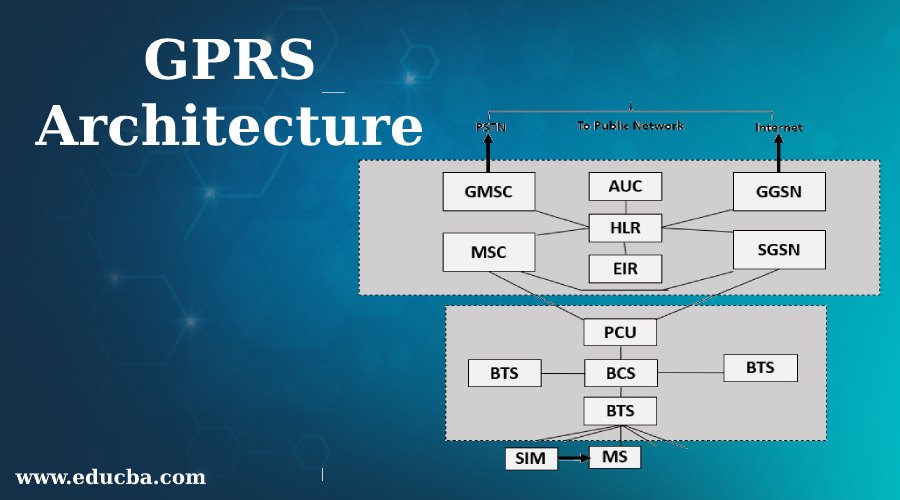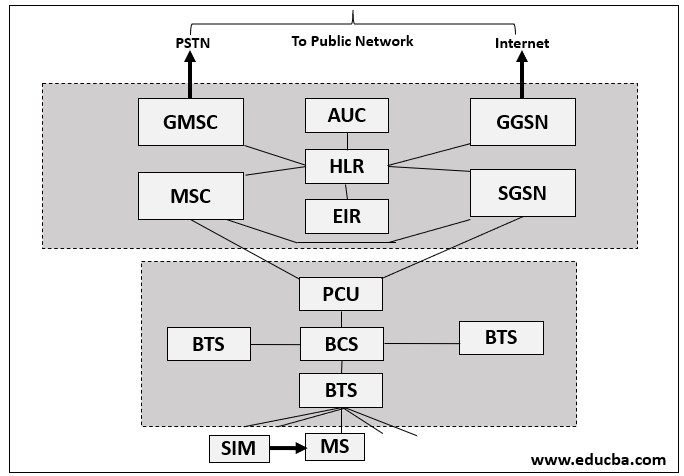
Introduction to GPRS Architecture
The architecture that works as a network to allow the passage of data is called GPRS Architecture. It has settings for packet data at a faster rate of 171 kbps. Multiple users can enter the network and use the resources judiciously. Involved from GPS, General Packet Radio Service provides packet service in 2G or 3G mobile data services. Short packets are accessed in a short duration with proper infrastructure, which provides the connection to GSM infrastructure. When 2G is provided with data, additional entities are needed for the same. They are GGSN and SGSN. Additional provisions are given to the architecture to improve itself.
What is GPRS Architecture?
1. GSM network elements are mostly used in addition to the new entities in the architecture. The nodes are supported for routing and proper enhancement of the data packets. These nodes are Serving GPRS Support Nodes (SGSN) and Gateway GPRS Support Nodes (GGSN). Also, the GPRS register stores information regarding the routing and maps it to the proper address.
2. SGSN helps in the services within a network, whereas GGSN helps in the gateway outside the network. Also, the Packet Control Unit or PCU is present in the network that helps to determine where the data should be routed. It is either given to packet-switched or circuit-switched networks in the system.
3. A protocol is used between SGSN and GGSN to look familiar and normal to the external users of the network. This helps in communication of the system via IP and does not face any issues from the system’s network backbone.
4. A Logical Link Control is used in the network so that when a mobile device moves to a new area, an old link is removed, and a new link is added under the new SGSN. This helps to make the network work under the system and manage them to carry all the data packets.
Components of GPRS Architecture
Below are the Components of GPRS Architecture:
- Most of the GSM elements are modified in the system to make them work as per GPRS architecture. Let us have a look at those elements.
- GPRS support nodes or GSNs helps in the proper working of GGSN and SGSN in the network. GSN should be installed in the system to make them deploy whenever we need it.
- Mobile Stations in GPRS help to access the services in the network so that they are used on time by the data packets. These stations help compete with the services backwards and forward and manage the GSM calls within the network. This service provides great help while doing backwards compatible services.
- Base Transceiver Station or BTS receives all the messages from the network and manages them to use the system. This makes the station manage the data fruitfully to the required mobile data packets.
- Also, the Base Station Controller or BSC makes the installation of PCU worthy of it by managing the data traffic and directing it to the necessary stations. A separate hardware element is needed in the system, or it installs all the elements within itself. Please upgrade to the systems is needed to make them work properly and use them to the full core.
- The routing Area in GPRS works similar to the Location Area in GSM to broadcast the same messages to the entire network in the area. Also, it handles the data with utmost care so that there are no data leakages while transferring the same message.
- Databases in the GPRS network help to handle the data and store it in the same network. Hence it is easy to retrieve the information whenever needed in the system and to manage them.
- SGSN helps in authenticating the mobile data, managing the mobiles, and interfering with the information in the system’s air interface. Also, the registration of mobiles in the network is taken care of by SGSN.
- GGSN has all the information of mobiles in the network and acts as an intermediary between router and external networks. The data packets are passed to the proper node through IP in the network, and it acts as a server backbone in the system. It acts as a filter to the traffic by controlling the data and collecting information from the external networks. Hence, it is a barrier to external attacks and protects the network.
Advantages of GPRS Architecture
Below are the advantages of GPRS Architecture:
- Data access time is concise in the architecture so that the data under any network or under any system can be accessed and used faster. This makes the network manage the data well under the system with proper data packets and routing area, and network backbone.
- All the resources are utilized to the maximum in the network, so that circuit switching, packet switching, and transmission modes are managed well. The routing area is described in the network so that wireless resources are identified and used.
- Through mobile devices, data is transferred at a faster rate than ever. GPRS networks can be used in computers so that the data transmission rate will be faster and can be utilized to its full capacity.
- Any applications are used in the GPRS network, be it common services like email or broadcast service in the system or web browsing in the network. It is a known fact GPRS provides services in the name as they stay always connected in the system. With the high transfer rate and shorter access times, GPRS is preferred in the system by many users.
- Multimedia messaging and broadcasting is easily done in GPRS. Instant messaging service is provided in the network to make use of this service to the maximum if the data transfer rate is slow. Wireless connectivity is provided in the system when data is at a very faster rate.
- Availability and accessibility of the GPRS network over all the systems make it trustworthy among the users.
Some wireless services offer their services at a lower rate than GPRS. Also, network speed is affected when many users surf the internet from the same locality under the same network.
Recommended Articles
This is a guide to GPRS Architecture. Here we discuss the Introduction and Components of GPRS Architecture along with its different advantages. You can also go through our suggested articles to learn more –

